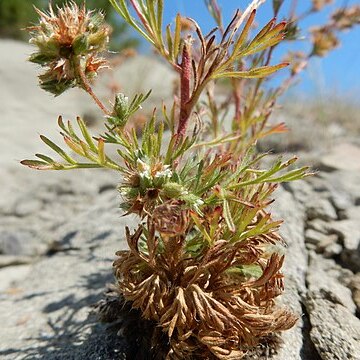Herbs biennial or annual, villous and glandular hairy. Roots woody. Flowering stem solitary, rarely few and tufted, erect or arcuate-ascending, 20–50 cm tall, slightly woody at base, often branched in upper 1/2. Radical leaves in a dense rosette, usually withering in fruit; stipules leaflike, 3-or more sect; petiole 1–2.5 cm; leaf blade 1–2.5 cm, 2 times 3-parted, base cuneate; lateral lobes 2-sect, median one often 3-sect into 3–5-fid segments; ultimate segments or lobes linear, 1–2 mm, margin entire, apex obtuse; cauline leaves resembling radical ones but subsessile and 3-parted. Inflorescence terminal, cymose, repeatedly dichasially branching into a many-flowered panicle 1.5–3 cm in diam.; bracts and bracteoles 2-or 3-fid with linear lobes. Flowers 2–3 mm in diam.; pedicel long, slender, 3–6 mm. Hypanthium turbinate or campanulate, ca. 1 mm. Sepals ovate-lanceolate, 1–2 mm, apex acuminate. Petals pale pink or white, obovate, 2–3 mm, glabrous, base tapering into a cuneate claw, apex rounded. Stamens shorter than petals. Carpels 10–15, free; ovary ovoid or cylindric; style lateral-basal. Achenes dark brown, ovoid or cylindric, 1–1.5 mm, glabrous, smooth, apex mucronate. Fl. and fr. Jun–Aug.
More
Glandular-pubescent and hirsute, short-lived perennial (seldom biennial) 1–3 dm, branched at least above; lvs dissected into blunt, linear oblong segments, the lower lvs long-petioled, the upper short-petioled to sessile and less divided or entire; hypanthium and lanceolate sep (these 2 mm) hispid; pet white, barely exceeding the sep. Dry plains and open hills; Alas. to Colo. and Utah, e. to w. Minn., and disjunct at Keweenaw Point, Mich.; c. and ne. Asia. June, July. (C. nuttallii)
Leaves: basal petiole to 30 mm; lobes of cauline leaves 5–18 × 0.2–1 mm; surfaces white-hairy, stipitate-glandular, hairs rarely antrorsely barbed. Flowers: sepals 1.8–2.5 mm; petals 1.8–2.5 × 0.5–1.1 mm. 2n = 14.

